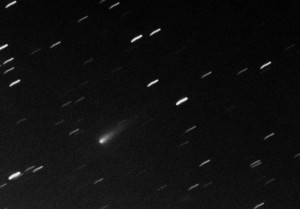Comet ISON is increasingly likely to appear brightly in the night skies of Earth in early December.
The results of studies released this week suggest ISON has the qualities needed to survive its Nov. 28th brush with the sun, a point in its journey toward the inner solar system called perihelion.
If computer studies carried out by the Lowell Observatory and the Southwest Research Institute are on the money, ISON will be a popular object of night time observation days later.
For astronomers ISON represents a rare opportunity to monitor a large first time comet make a one time journey around the sun. ISON is comprised of materials that formed the sun and the planets long ago.

ISON as viewed by UK astronomer Pete Lawrence with ground telescope. Image Credit/European Space Agency
Comets, however, are notoriously unpredictable and ISON’s fate could change, depending on the object’s size, composition and density.
As it skims the sun, ISON will experience temperatures reaching 5,000 degrees, according to the Lowell and SWRI computer assessment.
Unless it is large enough, much of ISON could boil away. In addition to the heat, ISON will experience “tidal” or gravitational forces that could disrupt it. ISON’s rotations, which were also evaluated in the computer analysis, could also influence its fate.
“Given current constraints on ISON’s nucleus properties and the typically determined values for these properties among all comets, the researchers found that comet ISON is very likely to survive its solar encounter and the forces of evaporation and tidal disruption unless other factors, such as rotational spin-up due to violent jets of gas, are unexpectedly strong enough to affect the comet substantially,” SWRI report concluded.

